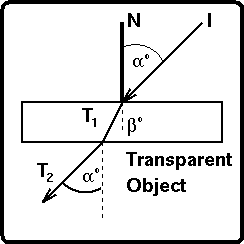 6.4. Transmission.
6.4. Transmission.  6.4. Transmission.
6.4. Transmission. Obeying the laws of physics, transmission also has two basic forms, regular and diffuse. Transparent glass exhibits regular transmission, whereas frosted glass exhibits diffuse transmission. However, unlike reflection, mixed transmission is very rare. The model used to implement this system includes only regular transmission.

Fig. 6.2 : Refraction.
Figure 6.2 demonstrates the refraction of the light ray as it
passes through a transparent object.
In that figure the following holds:

I = incident ray
N = surface normal
T1 = 1st refracted ray
T2 = 2nd refracted ray
 = angle of incidence
= angle of incidence
| -
- | = angle of refraction
| = angle of refraction













